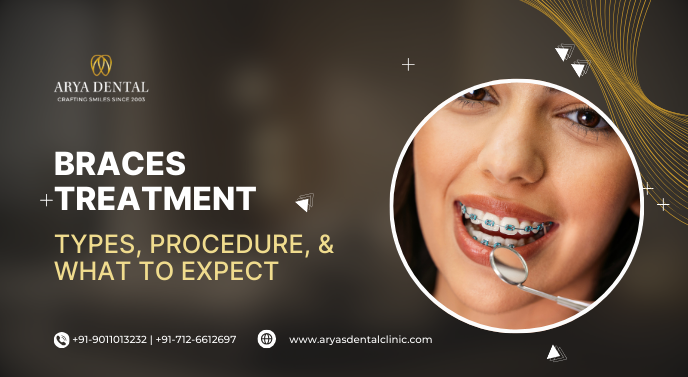
Having concerns and doubts before starting your orthodontic treatment is normal. After all, a perfect smile is a big decision! You may be asking yourself many questions as you consider braces to make your dream smile a reality.
What if the braces won’t look good on me?
What if my braces break off?
How will I maintain the braces?
These are valid questions, and in this blog, we have addressed them, along with other important details about braces treatment, types, procedures, and what you can expect during the process.
Types of Braces
When it comes to braces, there are several types to choose from, each with its own advantages and features. Here are the most common ones:
- Metal Braces: The most traditional and widely used option, metal braces are made from stainless steel or titanium. They are made up of metal brackets that are fastened to the teeth and joined by a wire. These braces work quite well and can be used for many dental problems.
- Ceramic Braces: These are made of clear or tooth-colored ceramic materials and function similarly to metal braces. They are less apparent since they mix in better with your natural teeth. They are usually more costly than metal braces, though, and might be slightly more brittle.
- Lingual Braces: Since they are positioned below the teeth, lingual braces are essentially undetectable from the outside. They function similarly to conventional metal braces, but they can occasionally be more unpleasant and take more skill to fit and modify.
- Clear Aligners (Invisalign): Clear aligners are transparent, removable trays that are custom-made to fit over your teeth. They are comfortable, easy to remove when eating or brushing, and virtually invisible, making them a popular choice for adults. However, they may not be suitable for severe orthodontic issues.
The Procedure
Getting braces is a simple, yet highly precise procedure, typically done in stages.
Consultation:
The first step is to see an orthodontist, who will examine your jaw and teeth. To develop a personalised treatment plan for you, they could take imprints and X-rays.
Braces Placement:
Once your plan is ready, your orthodontist will bond brackets to your teeth with a special adhesive. Then, they’ll insert a wire and secure it with small rubber bands. This process usually takes about 1-2 hours.
Adjustments:
After your braces are placed, you will need to visit the orthodontist every 4-6 weeks for adjustments. During these visits, the orthodontist will tighten the wires to move your teeth into place gently.
Completion and Removal:
The braces will be removed once your teeth are properly aligned. Depending on your specific needs, the entire process may take a few years. After removal, you may need to wear a retainer to help keep your teeth in their new position.
What to Expect
Before you make the decision, here’s what you can expect during your braces treatment:
Discomfort:
You could feel a little sore and uncomfortable at first, especially if the braces are worn or changed. The discomfort normally goes away in a few days, and over-the-counter pain medicines can be helpful.
Dietary Restrictions:
While wearing braces, certain foods such as sticky candies, hard foods, and chewing gum should be avoided. These can damage the braces or get stuck in them. Soft foods and cutting up hard foods into smaller pieces will be more comfortable.
Oral Hygiene:
Brushing and flossing can be a bit more challenging with braces, but it’s essential to maintain good oral hygiene. Use a soft-bristled toothbrush and special flossing tools designed for braces. Regular dental checkups will also be necessary.
Adjusting to New Habits:
You’ll need to get used to new habits, like wearing rubber bands or cleaning your braces regularly. Over time, it will become part of your routine, and you’ll be able to take care of your braces easily.
Answering Your Concerns
Now, let’s address the specific concerns you might have:
1) Will braces look good on me?
Braces are designed to improve your smile and come in various styles. If you're worried about appearance, ceramic braces or clear aligners are great options to keep things discreet. Remember, braces are a temporary step toward a more confident smile!
2) What if my braces break?
It’s very rare for braces to break. However, if a bracket or wire does become loose, don’t panic! Contact your orthodontist to find out the solution. Always avoid biting down on hard or sticky foods to minimize the risk.
3) How will I maintain the braces?
Brush and floss frequently to keep your braces in good condition. Steer clear of meals that are rough or sticky since they may harm your braces. Attend your scheduled orthodontic appointments for adjustments and follow your orthodontist's guidance on rubber band use.
Final Thoughts
Whether you are considering clear aligners, classic metal braces, or any other braces, the outcome will be worth the journey. Braces treatment is an investment in your long-term dental health and beauty, and they may significantly improve your smile and raise your confidence. If you’re still unsure which option is best for you, consult an orthodontist who can guide you through the decision-making process and help you choose the perfect solution for your needs.
Ready to transform your smile? The first step is just a consultation away!